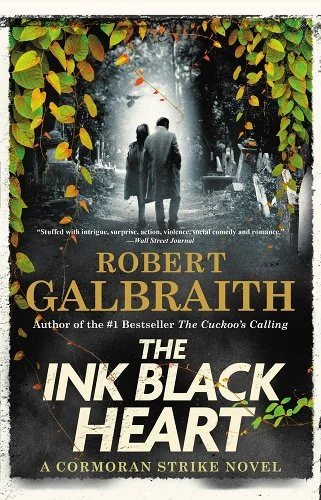Atlanta, GA. Robert Galbraith’s The Ink Black Heart caused controversy long before its publication. The novel is the sixth installment in Galbraith’s Cormoran Strike series, which details the adventures of a hardboiled London private investigator who also happens to be a disabled veteran. Much criticism of the books themselves has been dominated by its author’s public reputation – Robert Galbraith is a pen name for J.K. Rowling, most famous for her wildly popular Harry Potter series but recently maligned primarily due to public statements that media organizations and former fans alike perceive as transphobic. Complicating matters further, The Ink Black Heart centers around the murder of Edie Ledwell, the creator of a wildly popular YouTube cartoon whose viewers accuse Ledwell of being transphobic, racist, and ableist. While reviews of the book point out the obvious similarity to recent conversations surrounding Rowling, the author herself denies that it is a direct response to those events (Treisman).
As a disabled adult who grew up reading Harry Potter, I am incredibly heartened by the existence of a disabled series protagonist who is a complex, flawed, fully formed human being. Unlike many pop cultural representations of disability, which tend to either sentimentalize disabled people to inspire the able-bodied (think Dickens’s Tiny Tim) or portray disabled people as bitter, angry loners who cannot participate in healthy relationships (think Gregory House, M.D. as portrayed by Hugh Laurie), Cormoran Strike is no-nonsense and capable, has agency over his own life, has fulfilling relationships with friends and family, and even experiences several serious sexual relationships over the course of the series (many underdeveloped cultural representations of disabled people deny them sex lives altogether). These relationships always end because of his reticence to depend on his partners emotionally, however. Like all people, Strike has both strengths and weaknesses, and this makes him both a compelling protagonist and a positive example of disabled cultural representation.
Though the novel succeeds in that area, this success is unfortunately overshadowed in the public consciousness by the online discourse surrounding Rowling’s inflammatory statements. Both Rowling and her fans and critics repeatedly double down on their opposing viewpoints surrounding gender identity, particularly in online spaces. They craft long argumentative threads that do not accomplish reciprocal growth or thought development and instead exemplify the destructive human tendency of listening to respond rather than to understand. Take for example this Twitter thread from September 29, 2022, in which Rowling glibly calls out those who object to her statements regarding trans people, comparing their inability to produce satisfactory evidence of offensive statements to “when Joseph Smith found the golden plates and nobody else was allowed to look at them.”
As of the publication of this essay, that thread has over 1900 replies and over 3000 retweets, with most former fans responding that they are deeply hurt not only by her statements, but by her seeming inability to hear them when they say these statements constitute a sort of emotional betrayal by someone they consider as central to their development as empathetic readers, which they connect to the experience of reading the Harry Potter series.
Contrary to these unproductive public disagreements, however, the novel itself contains several devices and characters that encourage the reader to look at the world with a more nuanced eye, particularly through its depictions of internet culture and its presentation of multiple disabled characters that work together to create a spectrum of experiences that seem radically anti-ableist in a world where disabled representation is usually either flat or tokenistic. The way that anger, stubbornness, or willful ignorance obfuscate such nuance and humanity shows how difficult it is to recognize the value and dignity of other people.
Ironically, The Ink Black Heart’s cleverest device is its physical representation of the complexities of internet communities, which appears primarily through the depiction of in-game chats between the moderators of Drek’s Game. The game is inspired by Ledwell’s cartoon and the location of both the novel’s most ardent fans and Ledwell’s angriest critics. The moderator chats are oriented vertically on the book’s pages, and responses are separated by rows of arrows that denote the time in between messages. Each vertical column contains a single conversation such that one page of the novel may contain up to three different chats from left to right across the page. Arrows denote breaks in conversations. The orientation of the chats relative to the rest of the novel is purposefully disruptive – in order to follow one chat to its end, the reader must turn to the next page and continue the corresponding column. When that conversation ends, to read the next chat in the chapter, the reader must flip back to the previous page and begin again on the second column from the left, and so on. Thus, the way the chats are written causes the reader to read passages slowly and occasionally multiple times over the course of an entire chat section. This repetitive process also allows a careful reader to notice, through the placement of the arrows, who is speaking to whom and when, which moderators are closest to which, who they exclude, and other in-group dynamics important to the game’s community. The conversation breaks are, in fact, the key to solving the murder of one of the game’s moderators, Morehouse, whose real name is Vikas Bhardwaj. By reading closely enough to realize that Anomie (the murderer) and Paperwhite (Morehouse/Bhardwaj’s in-game girlfriend) are never chatting to the same person at the exact same time, it becomes clear that Anomie is Paperwhite and is catfishing Bhardwaj in order to keep him and his coding expertise involved with the game.
Understanding the fact that the dynamics of this internet community are complex and not what they seem at first glance is integral to solving the mystery at the novel’s center, suggesting that Rowling trusts her readers to understand that online communication involves complicated people and thus has the potential for depth and layers of meaning.
Bhardwaj, a talented Cambridge graduate student and the co-creator of Drek’s Game, is a wheelchair user and one of The Ink Black Heart’s four major disabled characters (including central protagonist Strike). In addition to creating a rare multiplicity of disabled experience in a single text, these characters help us to see various facets of our protagonist’s personality over the course of the novel as he interacts with disabled people like and unlike himself. As Strike and his investigative partner Robin Ellacott research Bhardwaj en route to interview him about Ledwell, Strike notes the darkly humorous significance that the college Bhardwaj attends at Cambridge – Gonville & Caius – “was named for Caius [who] was renowned for his unusual entry rules barring the sick and infirm.”
Later on the same page, Strike comments with some surprise that Bhardwaj clearly has lots of friends as evidenced by his social media photos and admits that he had assumed his reason for moderating the game was because he wasn’t keen to be with people. This depiction of Bhardwaj shows him simultaneously as someone who participates in typical social activities and yet attends an institution marked by negative assumptions and prejudices about disabled people. Furthermore, the fact that Strike’s descriptions of Bhardwaj acknowledge the inaccuracy of one disabled stereotype (disabled people are less valuable to society than able-bodied people) and then immediately assume the validity of another (disabled people are socially maladjusted) shows Strike’s own complexity as well as the fact that destructive stereotypes continue to form his own thinking.
As opposed to the likable and extroverted Vikas Bhardwaj, Inigo Upcott, who lives with myalgic encephalomyelitis, is the novel’s most negative disabled representation. He is also the most diametrically opposed to Strike temperamentally. Upcott is angry and abusive toward his children, refers to himself as “cut off in his prime,” and blames his friends and former coworkers for his withdrawal from public life. Strike is disgusted by the other man’s self-pitying attitude toward his illness, saying he “had no pity to spare for Inigo Upcott’s crushed dreams” because of his own road back from “[lying] on a dusty road in Afghanistan [with his] leg blasted off.” Strike further differentiates himself from Upcott, saying that unlike him, he “believes character is the most powerful determinant of life’s course.” Interestingly, though, Upcott’s characterization is not entirely negative. He runs a website from which an ME support group springs, and he offers advice and mentorship to Kea Niven, a young disabled artist. The novel doesn’t let readers see even the grumpy Upcott as a simplistic, unidimensional person.
Niven herself is arguably the most important disabled character in The Ink Black Heart because her online activism causes an evolution of thought and results in the development of stronger community in real life. She runs a popular tumblr for spoonies – the name for subscribers to spoon theory, a metaphor coined by blogger Christine Miserandino to communicate the idea that disabled people have a finite amount of energy that can vary from day to day and may be lower than that of able-bodied people. Between Upcott’s blog and Niven’s tumblr, the novel shows that internet community can have positive effects as well, adding more complexity to the negative impression of online spaces provided by Drek’s Game. Strike initially calls Kea’s tumblr “unattractively mawkish,” but after reading her encouragement not to see mobility devices as an admission of weakness, “his gaze move[s] unconsciously to the drawer where he keeps the collapsible walking stick Robin bought him,” and he eventually uses it when an on-the-job altercation puts extra stress on his hamstring. Though he does not directly state this – and Strike isn’t the kind of person who would, even to himself – it appears that relying on the stick Robin gave him makes him more comfortable relying on Robin herself for more of his physical needs. When he is hospitalized, he asks her to bring him healthy snacks because he wants to lose weight so he won’t put as much stress on his prosthesis. Robin recognizes what it takes for him to ask this of her but, “grateful to be permitted to do something for him,” does not bring it up in conversation. Thus, Kea’s online presence brings about positive change in other people’s lives, and in a book that is so much about the negative consequences of online communities, this looms large.
As such, by the end of the novel, Strike exists in a state of vulnerable interdependence that shows a profound growth and development. Not only is this a literary accomplishment, it’s an example that both his author and her critics – and, by extension, all of us who wish to live in compassionate community with one another – would do well to pay closer attention to.






4 comments
Martin
Great summary, Victoria. I can see your point but the link for “former fans alike” completely distorts the TERF viewpoint, simply shunning it like a contagion.
The TERF viewpoint is rooted in 1960s/1970s feminism, which claims that most of the behavior we identify as male or female is learned, not innate. In that light, to say “I have the body of a woman but I’m really a man inside” is open to question, namely, “What makes you think you’re a man inside?” Is it because you like to play rugby and don’t like to knit? But women do play rugby and men knit.
I think the “uncharitable” aspect is that trans activists are trying to express their feelings but claim some kind of objectivity about “ultimate nature” which is a philosophical point the TERF have addressed in great detail, with lots of research.
Katherine
…”Rowling’s inflammatory statements”. I must admit I never expected to see someone defending the simple truth that a woman is an adult human female, and that an individual’s biological sex is an incontrovertible fact, referred to as an “inflammatory statement”. Least of all on FPR.
Jeffrey Bilbro
Just to clarify, Victoria’s point–as I take it–is not about the position Rowling takes but with the inflammatory manner in which she expresses it. Those kinds of Tweets are much more likely to infuriate people who disagree with her than they are to persuade them.
Victoria Reynolds Farmer
Yes, that’s exactly it. My point was not to take a side in this debate, but to say that both sides of it are acting uncharitably to one another in a way that obscures the novel’s more interesting and compassionate content.
Comments are closed.